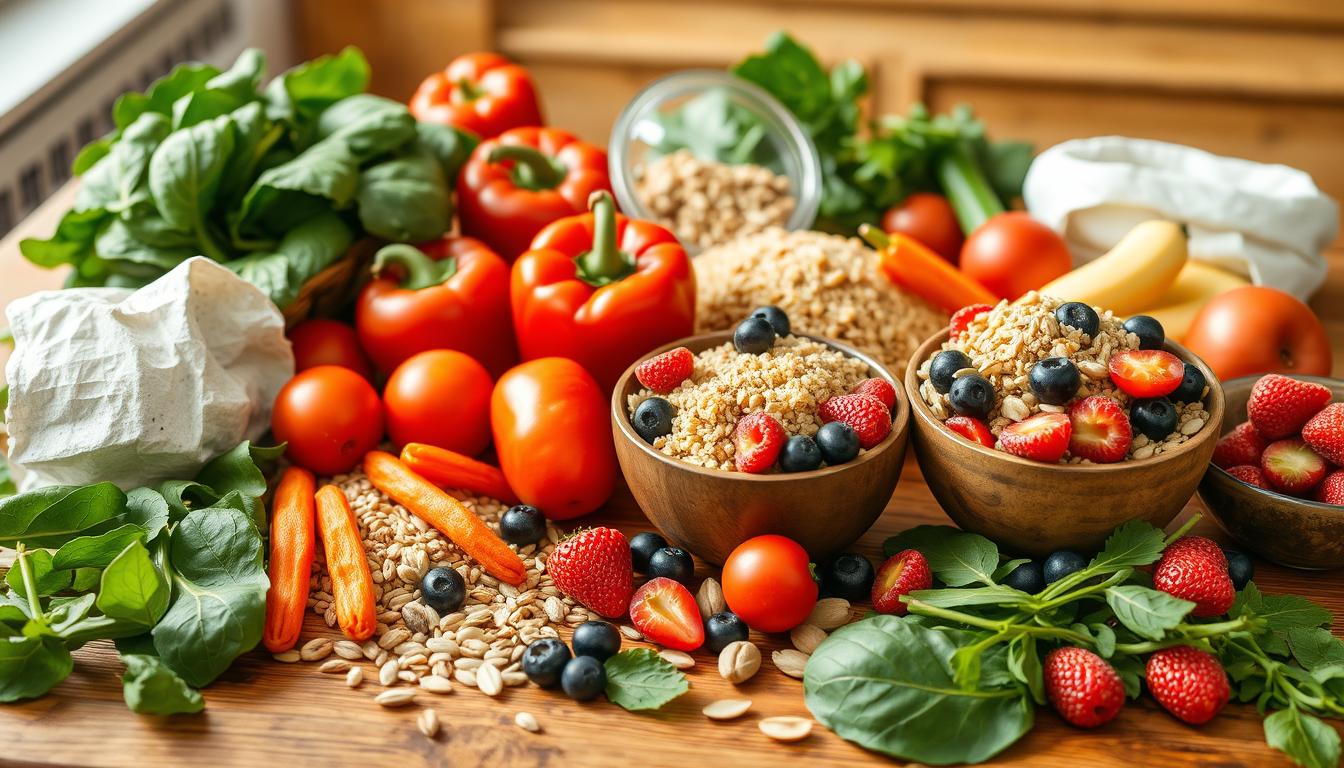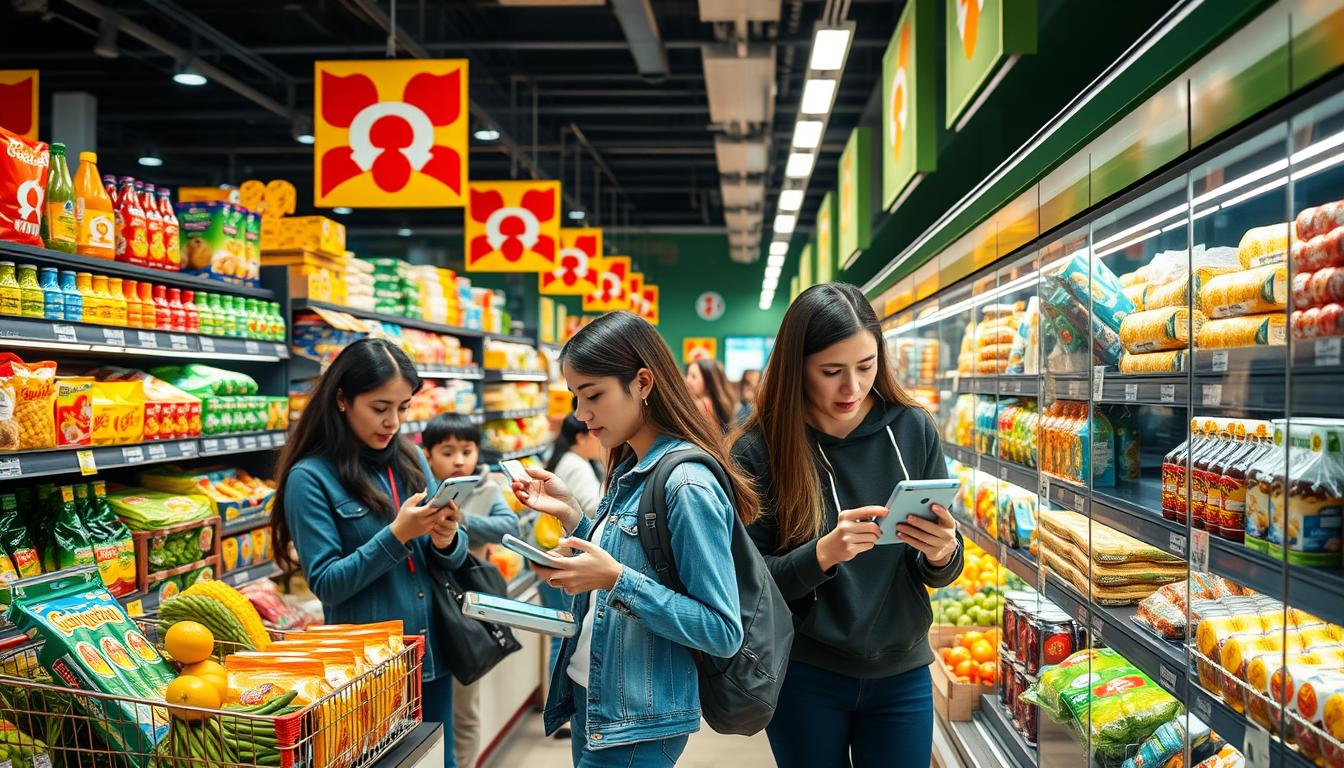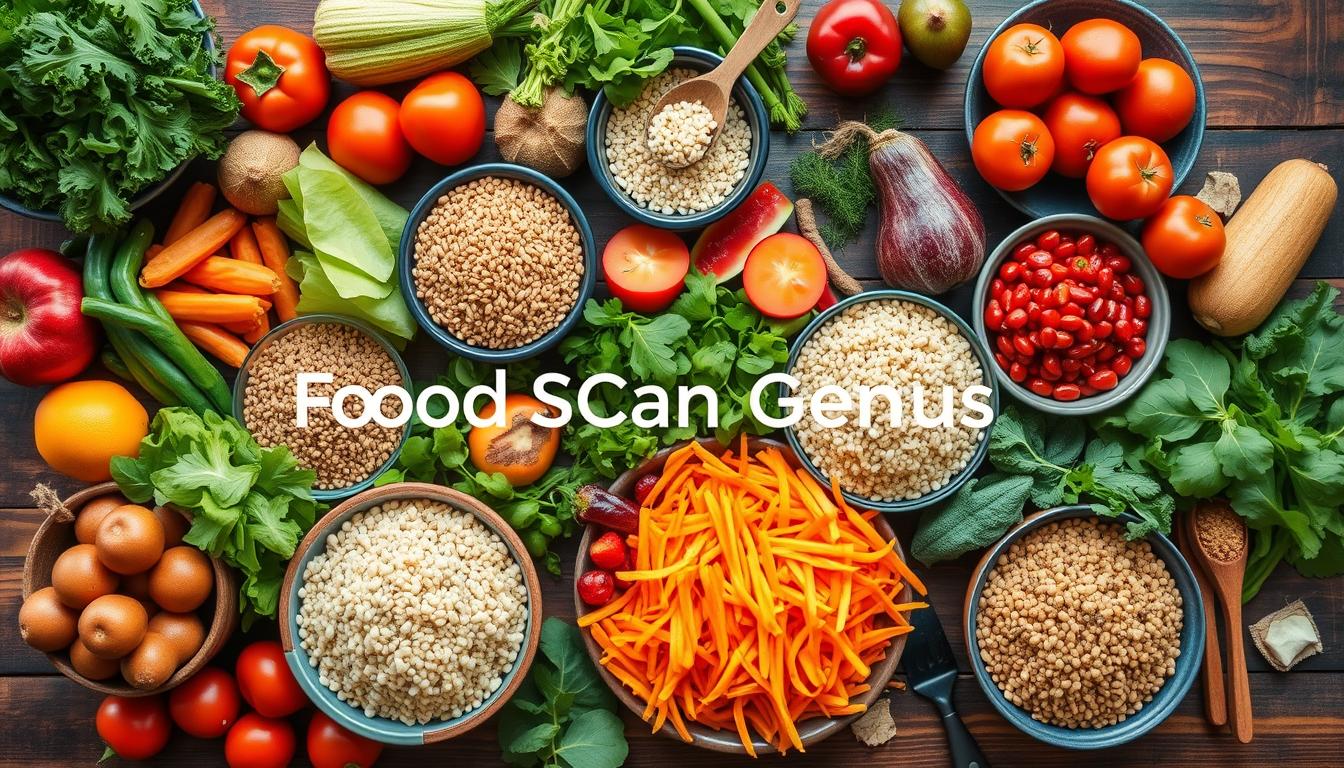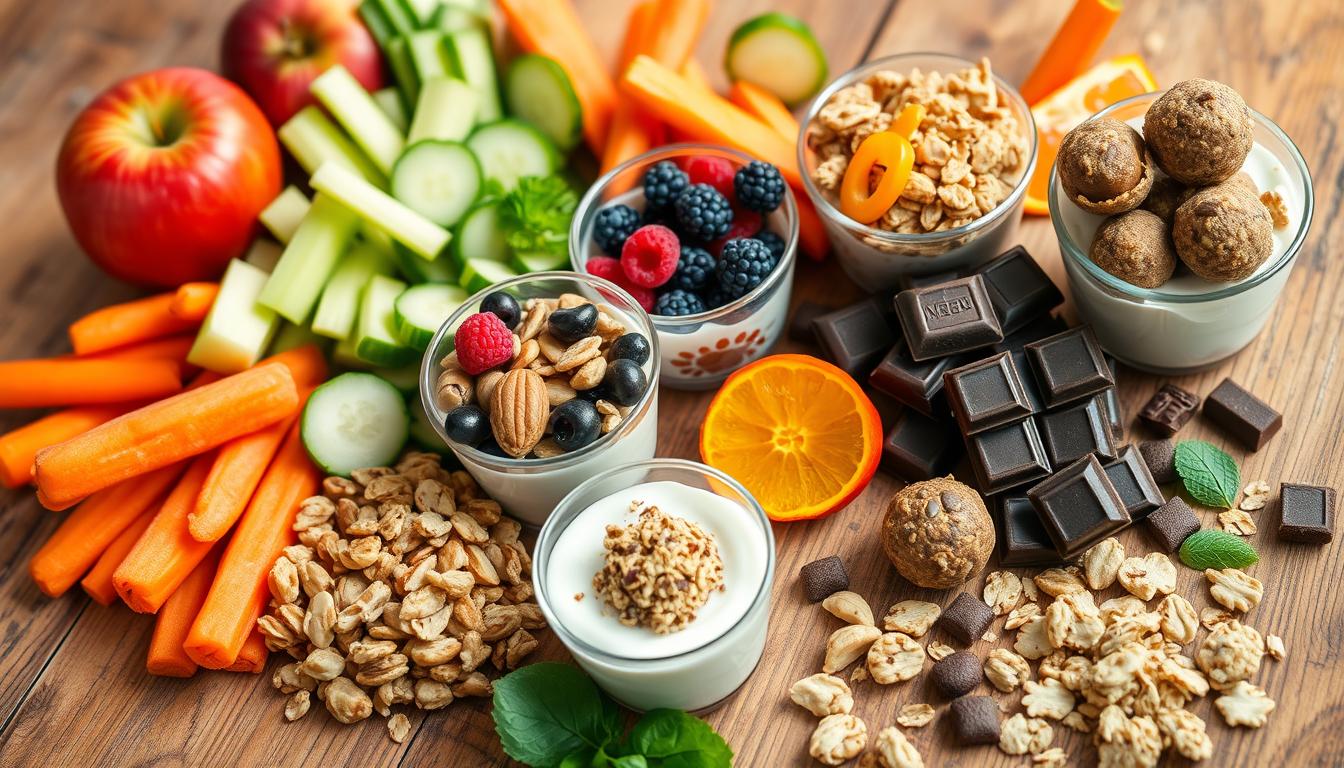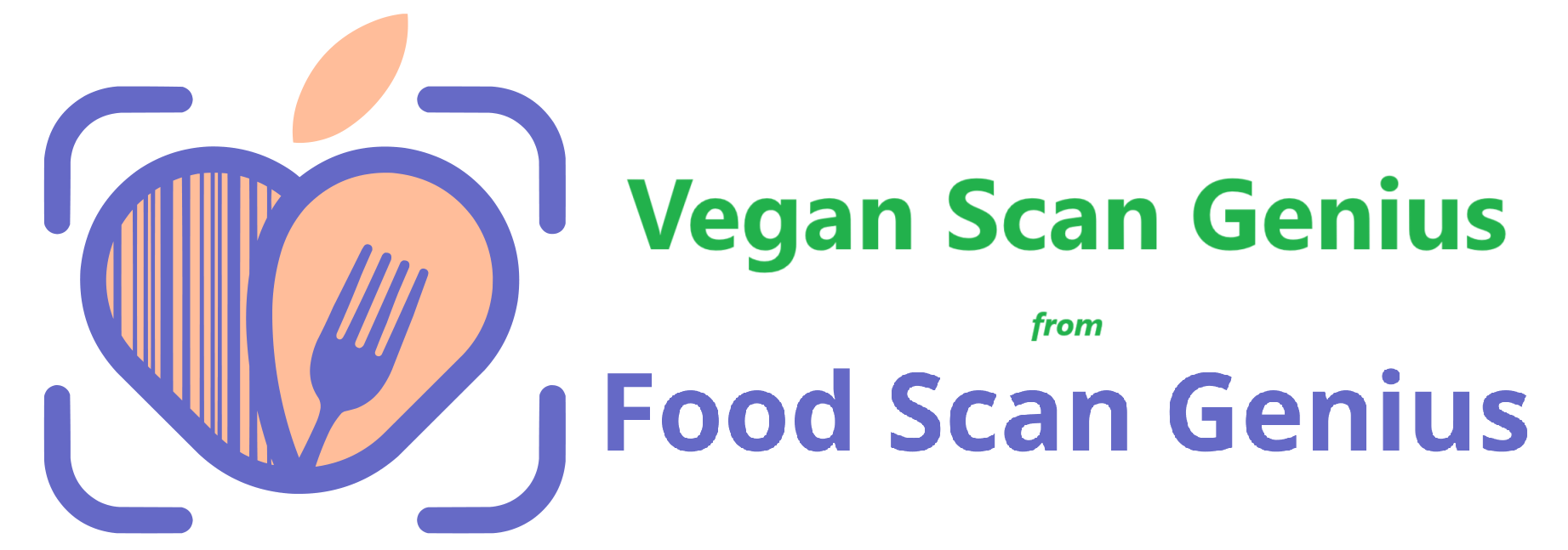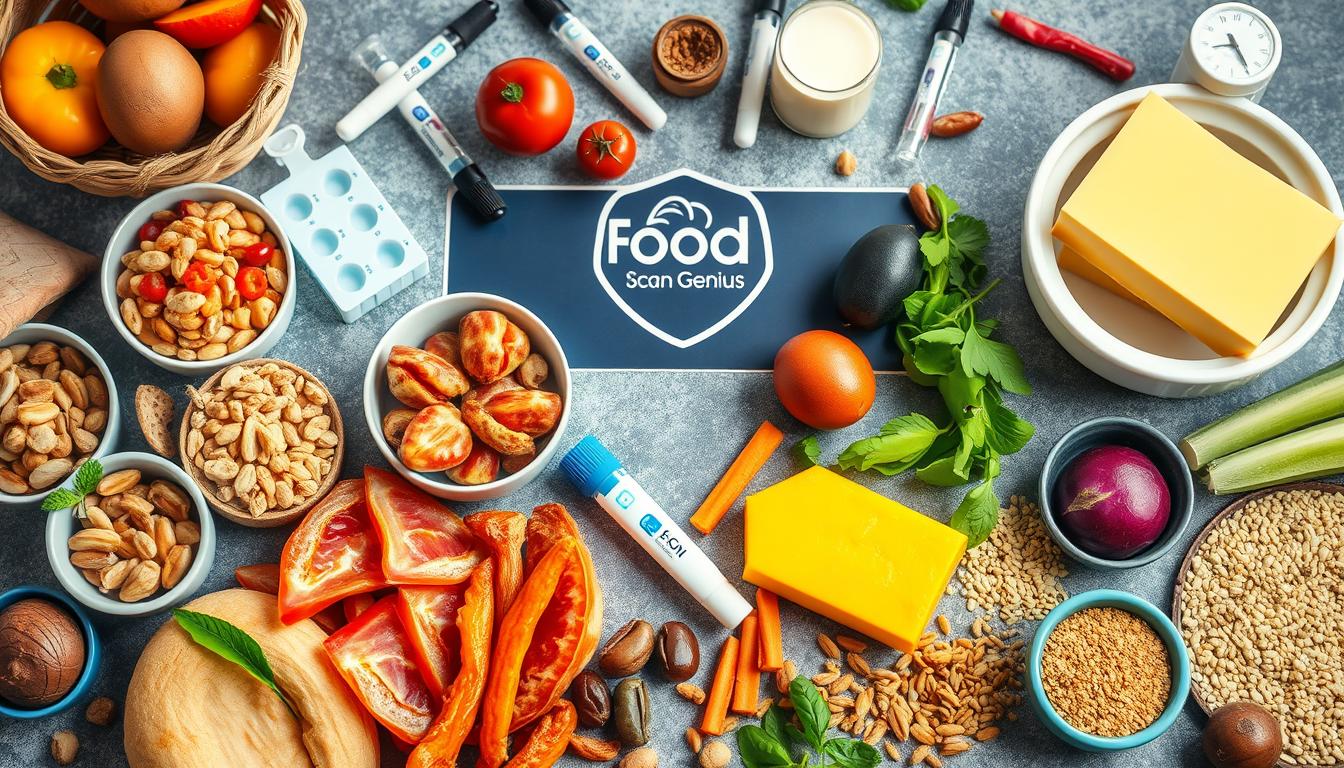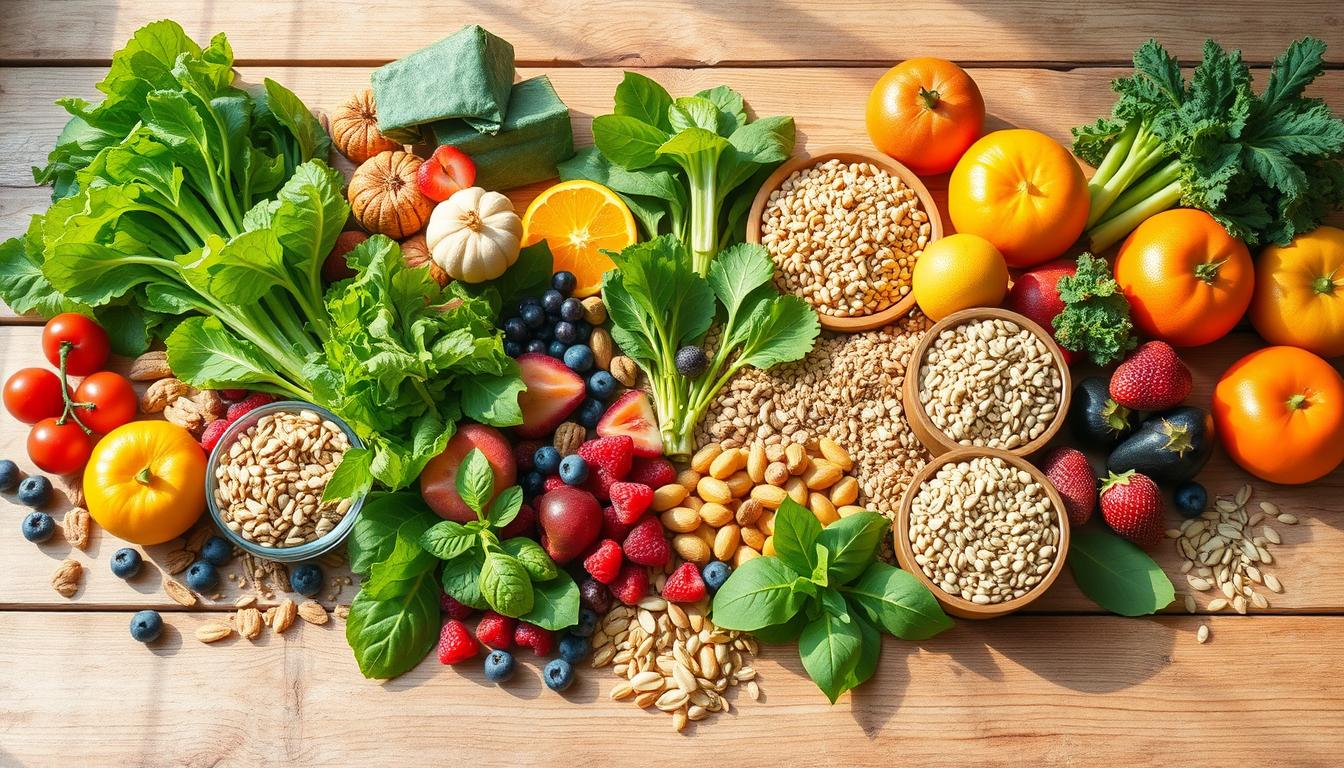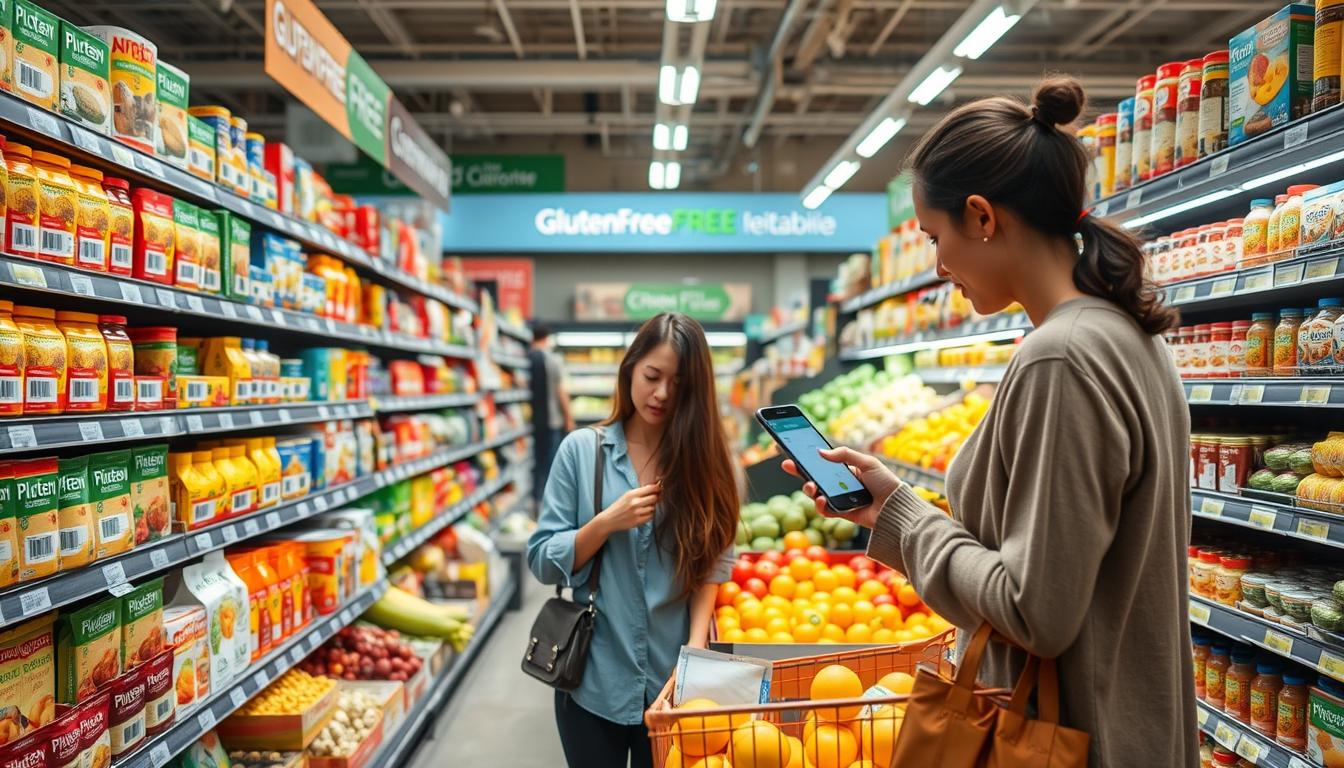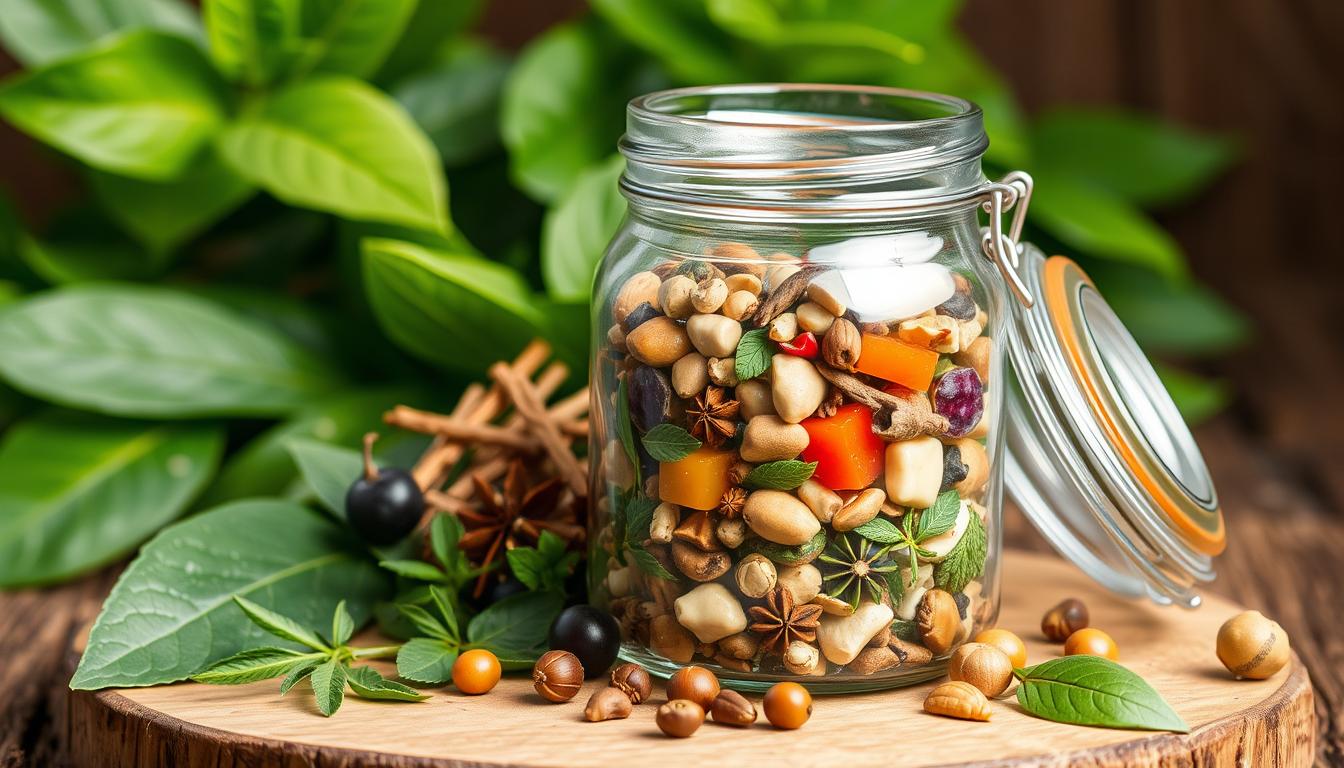Pssst, can you keep a secret? We’ve got the scoop on how to make delicious and healthy meals fast! Say goodbye to boring, unhealthy food and hello to clean eating. In this article, we’ll show you how to make tasty dishes quickly. These dishes will make your taste buds and body happy. Are you ready to find out how to make amazing, healthy meals? Let’s get started! Key Takeaways Discover quick and easy ways to incorporate wholesome ingredients into your meals. Learn how to plan nutritious meals that are both satisfying and delicious. Explore the benefits of clean eating and whole food-based recipes. Uncover time-saving tips for preparing healthy breakfasts, lunches, and dinners. Get inspired to elevate your cooking game with simple, yet nourishing meal ideas. The Essentials of Clean Eating and Meal Planning Starting a clean eating journey can be very rewarding. It’s about eating whole, natural foods that are full of nutrients. By knowing the importance of whole foods and how to shop smart, you can make your kitchen a place for healthy meals. Understanding Whole Food Ingredients Whole foods like fruits, veggies, grains, lean proteins, and healthy fats are key. They give your body the nutrients it needs. Eating these foods lets you enjoy their natural flavors and textures. Smart Shopping for Nutritious Ingredients Visit local farmer’s markets and specialty stores for fresh whole foods. Check nutrition labels to avoid processed foods with too much sugar, salt, and unhealthy fats. Choose organic produce to avoid harmful chemicals. Buy staples like quinoa, lentils, nuts, and healthy oils for quick meals. Basic Kitchen Tools for Healthy Cooking Having the right kitchen tools makes cooking clean eating meals easy. Get a good chef’s knife, a durable cutting board, strong pots and pans, and a reliable blender or food processor. These tools will help you cook healthy meals that taste great. Essential Kitchen Tool Benefits for Clean Eating Chef’s Knife Effortlessly chop, slice, and dice a variety of whole food ingredients. Cutting Board Provides a safe, stable surface for meal prep and minimizes cross-contamination. Pots and Pans Allows for versatile cooking methods, from sautéing vegetables to roasting whole foods. Blender or Food Processor Transforms whole foods into nutrient-dense smoothies, dips, and sauces. With these basics, you’re ready to make tasty, nutritious recipes that are good for you. Quick Breakfast Options Under 300 Calories Starting your day with a healthy breakfast is key. We’ve got quick, low-calorie breakfast ideas that are both nourishing and energizing. Enjoy creamy plant-based smoothie bowls or savory vegan breakfast sandwiches. All these healthy recipes are under 300 calories, perfect for busy mornings or when you’re watching your low-calorie intake. Overnight Oats with Berries and Chia Seeds: Prep this the night before for a grab-and-go breakfast. Mix rolled oats, almond milk, fresh or frozen berries, and a sprinkle of chia seeds. Top with a drizzle of honey for a naturally sweet treat. Avocado Toast with Poached Egg: Toast a slice of whole-grain bread, top it with mashed avocado, and finish with a perfectly poached egg. This protein-packed breakfast will keep you satisfied until lunchtime. Spinach and Feta Breakfast Wrap: Scramble a couple of eggs with fresh spinach and crumbled feta, then wrap it in a whole-wheat tortilla for a delicious on-the-go option. Breakfast Idea Calories Protein (g) Fiber (g) Overnight Oats with Berries and Chia Seeds 290 9 7 Avocado Toast with Poached Egg 280 12 6 Spinach and Feta Breakfast Wrap 260 16 5 Start your day with these quick and nutritious breakfast options. They’re delicious and won’t drain your energy. Try different ingredients and flavors to find your favorite healthy recipe. “Breakfast is the most important meal of the day, so make it count with these delicious and low-calorie options.” Plant-Based Lunch Ideas for Busy Professionals Busy professionals, we’ve got your lunch covered! These plant-based ideas are perfect for the office or remote work. They’ll keep you energized and focused all day. Protein-Rich Vegetarian Combinations These vegetarian lunches are packed with plant-based protein. They’ll keep you full and energized. Try a lentil and quinoa bowl or a veggie burrito with black beans, avocado, and salsa. Make-Ahead Lunch Box Solutions Prep your lunches ahead of time to save time. Make a big batch of healthy vegetarian chili or a colorful grain salad. Then, portion it out for easy meals all week. Quick Assembly Tips for Fresh Bowls Need a quick, nutritious lunch? Assemble a plant-based bowl. Start with greens or grains, add roasted veggies, edamame, and avocado dressing. Protein-Rich Vegetarian Combos Make-Ahead Lunch Box Solutions Fresh Bowl Assembly Tips Lentil and Quinoa Bowl Vegetarian Chili Greens or Grains Base Veggie-Loaded Burrito Colorful Grain Salad Roasted Vegetables Crisp Edamame Creamy Avocado Dressing Try these plant-based lunch ideas for a delicious, nutritious meal. Your body and mind will love you! Healthy Recipes That Take Less Than 30 Minutes In today’s fast world, it’s easy to forget about healthy eating. But don’t worry, we’ve got you covered. Our healthy recipes that are ready in under 30 minutes are here to help. These quick meals show that eating clean and whole doesn’t have to take forever. From one-pan dishes to speedy stir-fries, these recipes will change your weeknight dinners. You’ll enjoy tasty, healthy meals without spending hours cooking. Let’s explore some of our top picks for quick and healthy recipes! 30-Minute Chicken Stir-Fry This stir-fry is a weeknight savior. It combines tender chicken, crunchy veggies, and a tasty sauce in no time. Serve it over brown rice for a full, healthy meal. One-Pan Salmon and Roasted Vegetables Salmon is a nutritional superstar, and this one-pan dish makes it easy to enjoy. Just mix salmon with whole food veggies, season, and bake. In 25 minutes, you get a protein-packed, quick meal. 5-Ingredient Lentil and Sweet Potato Soup Hearty, clean eating has never been simpler. This soup needs just 5 ingredients and is ready in under 30 minutes. It’s a plant-based treat that’s good for your body and soul. Recipe Time to
Benefits of Using a Food Scanner App in 2025
Discover essential benefits of using a food scanner app in 2025. Learn how this technology revolutionizes grocery shopping, nutrition tracking, and food safety monitoring for healthier choices
Best Food Scanning Tools to Try in 2025
Discover the most advanced top food scanning tools to try in 2025 that help you make informed choices about nutrition, ingredients, and food safety for a healthier lifestyle
Easy Guide to Becoming a Healthy Vegetarian
Discover how to transition to a healthy vegan lifestyle with our comprehensive guide. Learn essential nutrition tips, meal planning strategies, and delicious plant-based recipes
10 Best Healthy Snacks for Energy and Weight Loss
Are you tired of unhealthy snacks that make you feel sluggish and guilty? We’ve got the answer! Get ready to find the 10 best healthy snacks that boost energy and aid in weight loss. These snacks are packed with protein and fiber, making them delicious and nutritious. Imagine enjoying crunchy almonds or creamy Greek yogurt with fresh berries. These snacks are guilt-free and keep you energized all day. But what makes them so special? Let’s explore the secrets behind these top healthy snacks. Key Takeaways Discover a variety of healthy snack options that can boost your energy and support weight loss Learn how to choose snacks that are packed with essential nutrients and macronutrients Understand the importance of portion control and mindful snacking for sustainable weight management Explore protein-rich and fiber-filled snacks that can keep you feeling full and satisfied Uncover low-calorie treats that don’t sacrifice taste, allowing you to indulge guilt-free Why Choosing the Right Snacks Matters for Weight Management Snacking can be tricky when trying to lose or manage weight. But, the right snacks can be a big help. They can increase your metabolism and keep you full. Plus, they help you control your portions for a healthy weight. Understanding the Connection Between Snacking and Metabolism Snacking can actually speed up your metabolism. The secret is to pick snacks full of protein, healthy fats, and complex carbs. These snacks require more energy to digest, boosting your metabolism. They also prevent your blood sugar from dropping too low, avoiding energy crashes and unhealthy cravings. The Role of Portion Control in Weight Loss Controlling your portions is key for weight management. It helps you stay in a calorie deficit for fat loss. It’s easy to eat too much when snacking. Measuring out your snacks and sticking to the sizes is crucial. By watching your portion sizes and choosing wisely, you can enjoy snacking without gaining weight. Finding the right balance between satisfying your hunger and controlling portions is key. With smart snacking, you can boost your metabolism, stay full, and reach your weight loss goals. Smart Snacking Guidelines for Sustainable Weight Loss Ready to make your snacking work for you? We’re excited to share our go-to guidelines for choosing nutrition bars, balanced snacks, and mindful eating practices that support sustainable weight loss. These tips will help you snack smarter and feel great doing it! First and foremost, focus on creating a balanced snack that combines protein, fiber, and healthy fats. This trifecta of nutrients will keep you feeling full and satisfied, preventing those mid-afternoon energy crashes. Some of our favorite balanced snack options include: Greek yogurt with fresh berries and a sprinkle of nuts Sliced apple with almond butter Hummus with carrot and cucumber sticks Portion control is also key when it comes to mindful eating. Avoid mindlessly munching straight from the bag or box. Instead, take the time to portion out your snack into a small bowl or plate. This simple practice can make a big difference in how much you ultimately consume. Snack Portion Size Nutrition bars 1 bar Trail mix ¼ cup Popcorn 3 cups popped Finally, be mindful of your snacking habits. Avoid mindless eating in front of the TV or computer. Instead, take a moment to sit, savor, and truly enjoy your balanced snack. This heightened awareness can help you make more nutritious choices and feel more satisfied. Remember, the key to sustainable weight loss is finding snacks that nourish your body and satisfy your cravings. By following these smart snacking guidelines, you’re on your way to a healthier, happier you. Protein-Rich Snacks to Keep You Fuller Longer Protein is key to feeling full and energized between meals. We have a tasty selection of protein-packed snacks. They will keep your hunger at bay and help you reach your weight loss goals. Plant-Based Protein Snack Options For plant-based protein, try these tasty and healthy snacks: Edamame – These soy-based pods are full of plant-based protein, fiber, and vitamins. Protein balls – Made with nut butters, oats, and dried fruit, they’re a protein-rich treat. Roasted chickpeas – Crunchy and savory, they’re a great snack instead of chips. Animal-Based Protein Snack Choices For animal-based protein, check out these options: Greek yogurt – It’s creamy, tangy, and full of protein. Enjoy it with fruit and nuts. Hard-boiled eggs – They’re easy to take with you and are very protein-rich. Jerky – Choose high-quality jerky for a tasty, protein-packed snack. These protein-rich snacks work for everyone, no matter your diet. Stock up on your favorites. Enjoy feeling full and supported in your weight management journey. Fiber-Packed Healthy Snacks for Digestive Health We’ve found snacks that are good for our bodies and taste great. These snacks are full of fiber. Fiber helps our digestive system and keeps us full longer, which is good for weight control. Fruit chips are a favorite snack of ours. They’re made from fresh fruits like apples and pineapples. These chips are crunchy and sweet, and they’re a healthier choice than sugary snacks. They’re also great with Greek yogurt for extra protein. Veggie straws are another favorite. They’re crispy and full of plant-based fiber. They come in many flavors. We enjoy them with hummus or guacamole for a tasty and healthy snack. Craving something heartier? Try roasted high-fiber snacks like chickpeas or edamame. They’re crunchy and nutritious. For a sweet treat, try baked oatmeal bars or homemade granola. They’re made with oats, nuts, and dried fruit. Adding these fiber-rich snacks to our diet is good for our bodies. It also helps our digestive health. Snacking has never been more satisfying and healthy! Low-Calorie Options That Don’t Sacrifice Taste Low-calorie doesn’t have to mean boring. We’ve got a lineup of mouthwatering snacks that’ll satisfy your sweet and savory cravings without breaking the calorie bank. Get ready to indulge in these guilt-free treats that taste anything but “diet”! Natural Sweet Treats Under 100 Calories Satisfy your sweet tooth with these delectable low-calorie snacks made with natural sweeteners. From
Going Vegan: Your Guide to Plant-Based Living
Discover the essentials of going vegan with our comprehensive guide. Learn about plant-based nutrition, meal planning, and easy tips to transition to a sustainable vegan lifestyle today
Food Allergy Testing: Know Your Triggers & Stay Safe
Understanding food allergies is key in today’s health world. Whether you’ve had allergies your whole life or just found out about a new one, testing can change how you eat. Let’s explore how food allergy testing works, from how our bodies react to common allergens to the different tests available. This will help you find out what you’re allergic to and stay safe. Key Takeaways Food allergy testing is crucial for identifying your specific triggers and managing your diet and health. Understanding the immune system’s role in allergic reactions is key to understanding food allergies. Skin prick tests, blood tests, and patch testing are the main methods for food allergy detection. Preparing for your food allergy test and interpreting the results are essential steps in the process. Advanced testing technologies, like the Food Scan Genius, can provide deeper insights into your food sensitivities. Understanding Food Allergies: The Basics of Immune Response Food allergies can be confusing, but knowing the science helps manage health. We’ll explore how our immune system reacts to certain foods. We’ll also look at common allergens that can cause these reactions. Common Food Allergens and Their Effects Common allergens include dairy, eggs, peanuts, tree nuts, wheat, soy, fish, and shellfish. When we encounter these, our immune system sees them as threats. It releases histamine to fight them, causing symptoms like hives and swelling. Digestive issues and severe reactions like anaphylaxis can also occur. Anaphylaxis is very dangerous and can be life-threatening. Distinguishing Between Allergies and Intolerances It’s key to know the difference between food allergies and intolerances. Allergies involve the immune system. Intolerances are about not being able to digest certain foods well. Food intolerance tests and allergen tests help figure out what’s causing your symptoms. They guide your treatment plan. The Role of Antibodies in Allergic Reactions Antibodies, especially IgE, are key in allergic reactions. When you’re exposed to an allergen, your body makes IgE antibodies. These antibodies recognize the allergen for future responses. When you’re exposed again, these antibodies bind to the allergen. This causes histamine release and other chemicals, leading to symptoms. Understanding food allergies helps you identify and manage your triggers. It’s essential for a healthy, fulfilling life. Next, we’ll explore the importance of professional food allergen tests and available testing methods. The Importance of Professional Food Allergy Testing Managing food allergies is crucial, and allergy blood tests and food sensitivity tests are key. These tests help find the exact foods that cause problems. This knowledge lets you avoid those foods and live better. Professional tests can tell the difference between food allergies and intolerances. Both can make you feel bad, but they need different treatments. A doctor can give you a detailed plan based on your test results. Trying to figure out food allergies by yourself can be dangerous. It might mean cutting out foods you don’t need to or missing treatments that could help. Professional food allergy testing gives you a clear picture of your allergies. It also shows how serious your reactions are, helping you make smart choices about what you eat. Accurate diagnosis through professional food allergy testing is crucial for effectively managing your condition and improving your quality of life. Also, tests can find food sensitivities that might be causing health problems like digestive issues or skin conditions. Finding and fixing these problems can greatly improve how you feel overall. In short, getting allergy blood tests and food sensitivity tests is a smart move for your health. It’s important to work with your doctor to get a plan that’s just right for you. Benefits of Professional Food Allergy Testing Risks of Self-Diagnosis Accurate diagnosis of specific food allergies Identification of severity and triggers Personalized treatment and management plan Reveal hidden food sensitivities Improve overall health and well-being Potential for missed or misdiagnosed allergies Unnecessary food restrictions Delayed access to effective treatment Increased risk of severe reactions Missed opportunities for comprehensive management Types of Food Allergy Testing Methods We have many ways to find out about food allergies. From skin prick tests to blood tests, each method gives us clues. Let’s look at the best ways to find out what you’re allergic to. Skin Prick Testing Procedures Skin prick tests are a simple way to find food allergens. A doctor will put a small amount of the suspected allergen on your skin. Then, they’ll prick it to let the allergen in. If you’re allergic, your skin will get red, swollen, and itchy in 15-20 minutes. This test is quick and doesn’t hurt much. It can tell us a lot about your allergies. Blood Tests for Food Allergies A food allergy blood test checks for IgE antibodies in your blood. These antibodies cause allergic reactions. Doctors can see which foods make your immune system react too much. Blood tests are great for finding hidden allergies. They can spot allergies that skin prick tests might miss. Patch Testing Options Patch testing finds food sensitivities and skin reactions. Small amounts of suspected allergens are put on your skin with patches. The patches stay on for 48 hours, and then your skin’s reaction is checked. This test is good for finding contact dermatitis. It’s a skin inflammation from touching an allergen. Patch testing can show which foods or substances cause your skin problems. Knowing the good and bad of each test helps you and your doctor find the best way to figure out your allergies. This way, you can make a plan to manage them. Preparing for Your Food Allergy Test: Essential Steps Getting a food allergy test is a big step towards understanding your diet. To get the best results, you need to prepare well. Here are the key steps to take before your test. Dietary Restrictions: Before your test, you might need to skip certain foods that could cause an allergic reaction. Your doctor will tell you which foods to avoid and for how long. Medication Considerations: Some medicines, like antihistamines, can mess with allergy test results. Talk to your
Heart-Healthy Diet: Your Guide to Cardiovascular Wellness
Are you ready to improve your heart health with nutrition? Buckle up, because we’re starting an exciting journey to better heart health! In this guide, we’ll explore the secrets of a heart-healthy diet. You’ll learn about the key nutrients, smart food choices, and tips to make your heart stronger and healthier. Key Takeaways Understand the connection between diet and cardiovascular health Explore the key components of a heart-healthy nutrition plan Discover power-packed plant-based foods that protect your heart Learn about the role of healthy fats and omega-3s in heart health Discover how to make informed food decisions with the help of the Food Scan Genius app Understanding Cardiovascular Wellness Through Nutrition Our hearts work hard every day, pumping blood and oxygen to all our cells. But did you know that what we eat affects our heart’s health? Let’s explore how diet impacts our heart health. The Link Between Diet and Heart Health What we eat affects our cholesterol, triglycerides, and inflammation levels. These factors are crucial for heart health. Eating foods that promote cardiovascular health can help keep blood pressure in check and prevent artery blockages. Key Components of Cardiovascular Nutrition To keep your heart healthy, focus on these key nutrients: Fiber – Found in fruits, vegetables, and whole grains, fiber helps lower cholesterol management and regulate blood sugar levels. Omega-3s – These healthy fats in fatty fish, walnuts, and flaxseeds reduce inflammation and improve heart function. Antioxidants – Foods like berries, leafy greens, and tomatoes protect your heart from free radicals. Impact of Poor Diet on Heart Disease A diet full of saturated and trans fats, added sugars, and refined carbs can harm your heart. These foods raise cholesterol management, blood pressure, and inflammation. This increases the risk of heart attack and stroke. Understanding how our diet affects our heart health helps us make better choices. This supports our overall balanced nutrition and well-being. Heart-healthy Diet: Essential Guidelines and Principles Getting a heart-healthy diet is easy. It’s about making small, lasting changes. These changes can greatly improve your heart health. Let’s look at the key guidelines and principles for a heart-healthy diet. Reduce Sodium Intake One key step is to cut down on sodium. Too much sodium can lead to high blood pressure, a major heart disease risk. Try to stay under 2,300 milligrams of sodium a day. If you have health issues, aim for even less. Embrace Whole, Unprocessed Foods Whole, minimally processed foods are the heart of a healthy diet. These include fruits, veggies, whole grains, lean proteins, and healthy fats. Eating these foods nourishes your heart and boosts your overall health. Increase Fiber Intake Fiber is vital for heart health. Eating foods high in fiber, like oats, lentils, berries, and leafy greens, can lower cholesterol and heart disease risk. Aim for 25-30 grams of fiber daily. Choose Heart-Healthy Fats Not all fats are good for your heart. Focus on unsaturated fats in avocados, nuts, and olive oil. Avoid saturated and trans fats found in processed foods and fried items. By following these guidelines, you can make your diet heart-healthy. Small changes can lead to big improvements in your heart health. Power-Packed Plant-Based Foods for Heart Protection Hey, heart health fans! Get ready to learn about the key to a healthy heart – plant-based foods. These foods are full of nutrients and offer many benefits for your heart. We’ll explore tasty options like leafy greens, whole grains, and berries. Leafy Greens and Heart Benefits Kale, spinach, and other leafy greens are true heroes. They’re rich in fiber and antioxidants, making them great for your heart. These greens are packed with vitamins and minerals that help lower blood pressure and improve cholesterol levels. Whole Grains and Fiber Sources Whole-wheat bread and pasta Brown rice and quinoa Oats and barley Adding whole grains to your diet is a smart move for your heart. They help control blood sugar, lower cholesterol, and keep your digestive system healthy. All these benefits are key for a strong heart. Heart-Healthy Fruits and Berries Fruits and berries are full of antioxidants and nutrients good for your heart. Blueberries, raspberries, and strawberries are especially good. They can reduce inflammation, improve blood vessel function, and lower the risk of heart attack and stroke. Fruit/Berry Key Heart Benefits Blueberries Rich in antioxidants, may improve blood pressure and cholesterol levels Raspberries High in fiber, may help regulate blood sugar and reduce inflammation Strawberries Packed with vitamin C, may improve blood vessel function and reduce heart disease risk Explore the world of plant-based foods and see how they can boost your heart health. Your heart will thank you! Smart Protein Choices for Cardiovascular Health Choosing the right protein is key for a heart-healthy diet. Not all proteins are good for your heart. We’ll look at the best options that are tasty and heart-friendly. Lean meats like chicken, turkey, and some beef are great. They’re low in bad fats and full of good nutrients. For a plant-based choice, try legumes, lentils, and tofu. They’re packed with fiber and antioxidants that help your heart. Protein Source Cardiovascular Benefits Chicken Breast Low in saturated fat, high in lean protein Salmon Rich in heart-healthy omega-3 fatty acids Lentils Packed with fiber, protein, and antioxidants Tofu Cholesterol-free, plant-based source of protein To keep your heart healthy, mix up your protein sources. Include both plant-based foods and lean meats. This will nourish your body and support your heart health. The Role of Healthy Fats and Omega-3s Not all fats are the same when it comes to heart health. We’ve been told to avoid fat, but some fats are good for our hearts. Omega-3 fatty acids are key for heart health and managing cholesterol. Benefits of Omega-3 Fatty Acids Omega-3s are important for reducing inflammation and lowering blood pressure. They help keep your heart healthy. Research shows they can lower triglyceride levels, increase HDL (good) cholesterol, and reduce the risk of heart attack and stroke. Best Sources of Heart-Healthy Fats Fatty fish like salmon, mackerel,
Best Gluten Free App Scan Barcode for Easy Shopping
Hey there, gluten-free friends! 👋 We’re excited to introduce you to Food Scan Genius, your new shopping buddy. It’s like having a super-smart bestie in your pocket! 🤳 This app is the world’s best AI assistant for those with food allergies and dietary restrictions. With over 500,000 products in our database (and growing!), we’ve got you covered. Just snap a pic of that barcode, and boom! 💥 You’ll know if it’s safe for you in seconds. No more squinting at tiny ingredient lists or feeling overwhelmed in the grocery store. We’ve got your back, and we’re here to make your gluten-free journey a breeze! Ready to simplify your shopping? Download Food Scan Genius at https://food.scangeni.us today and let’s get scanning! 🛒✨ Key Takeaways Food Scan Genius is the ultimate shopping companion for those with gluten-free dietary needs. The app has a comprehensive database of over 500,000 products, making it easy to quickly identify safe options. Barcode scanning technology allows users to instantly check if a product is gluten-free, eliminating the need to read small ingredient labels. The app is designed to be user-friendly and accessible, with features to support a gluten-free lifestyle. Food Scan Genius is the #1 Gluten-Free App on the USA App Store, trusted by users for its accuracy and convenience. Understanding Celiac Disease and Gluten Sensitivity Celiac disease is an autoimmune condition where your immune system attacks your own tissues when you eat gluten. Gluten is in wheat, barley, and rye, found in pasta and sauces. For those with celiac disease, gluten can cause symptoms like digestive issues and extreme fatigue. What Triggers Gluten Reactions When someone with celiac disease eats gluten, their immune system sees it as a threat. This leads to damage in the small intestine, affecting nutrient absorption and causing side effects. Common Symptoms and Diagnosis Symptoms of celiac disease vary, from digestive problems to anemia and joint pain. Doctors use blood tests, endoscopies, and biopsies to diagnose it. Impact on Daily Life Living with celiac disease means avoiding gluten in your diet. This can be hard, as gluten is in many foods. Grocery shopping, eating out, and social events become more complicated. But, managing a gluten-free lifestyle is doable with the right tools. Apps like Spoonful help with ingredient checker, dietary restriction assistance, and allergen avoidance. “For accurate information and support, individuals with celiac disease are advised to avoid online forums and work closely with a specialized dietitian to understand the lifestyle and dietary changes.” The Evolution of Gluten Free Shopping Apps Remember when finding gluten-free foods meant carrying a huge list? 📚 Those times are long gone. Now, we have many mobile health apps that make shopping easy. These apps are perfect for anyone following a gluten-free lifestyle. Scanning a barcode now tells us if a product is safe. These apps have huge databases, with over 500,000 products in the Food Scan Genius app. This makes shopping a lot easier. These apps are not just about data. They are also easy to use and very helpful. Users love them, giving them high ratings. One user said the app has been a big help since they found out they had gluten intolerance. The app has been accurate following my diagnosis of gluten intolerance in September, with only minor inconveniences related to seasonal products and barcodes sometimes showing different product items. New apps are even more advanced. They now offer meal planning, shopping lists, and personalized product suggestions. They are a complete solution for your mobile health and grocery shopping aid needs. If you’re tired of the stress of finding gluten-free foods, there’s good news. The future of mobile health and grocery shopping aid is here. It’s more powerful than ever. How Gluten Free App Scan Barcode Technology Works Ever wondered how our barcode scanning technology works? Well, wonder no more! Our app, Food Scan Genius, makes gluten-free shopping easy and fun. Barcode Scanning Process It’s simple. Just open the app and scan a product’s barcode. Our mobile health tech reads it fast. No more squinting or frustration. Database Integration Our ingredient checker database is huge. It has over 500,000 products, including 80,000 gluten-free ones. Scan a product and our app checks it against this vast library. Real-time Results Interpretation And the results come fast. You get the answer in seconds. No more guessing or last-minute changes. Just quick, reliable info for your shopping. Ready to try it? Download Food Scan Genius. Let our barcode scanning technology change your gluten-free shopping forever! Features of Food Scan Genius App Get ready for the ultimate gluten-free shopping tool – the Food Scan Genius app! It has a fast barcode scanner. You can check if over 500,000 products are gluten-free. But there’s more to this app. Looking for something specific? No worries! You can search by name, brand, or category. Want to know the ingredients? Our list of safe and unsafe ingredients is here for you. And for eating out, our dining and travel cards make it easy. Feeling adventurous? Our “Discover Gluten Free” feature introduces you to new gluten-free products. Our team of experts keeps our database current. You can trust the info you get. It’s like having a gluten-free genie in your pocket! Download the Food Scan Genius app today. Say goodbye to the guesswork of gluten-free shopping. With its great features, you’ll never worry about hidden gluten again. Feature Description Barcode Scanning Instantly check the gluten-free status of over 500,000 products by scanning their barcodes. Product Search Search for specific items by name, brand, or category to find exactly what you need. Ingredient Database Access a searchable list of safe and unsafe ingredients to ensure your purchases are gluten-free. Dining and Travel Utilize our comprehensive dining and travel cards to navigate the gluten-free landscape with ease. Discover Gluten Free Explore new and exciting gluten-free products with our “Discover Gluten Free” feature. Expert Curation Rely on our team of registered dietitians and nutritionists to maintain an accurate and up-to-date database. Food Scan Genius is
Ingredient Transparency: What’s Really in Your Products
In today’s world, we all want to know what’s in our products. We have the right to know what we put in our bodies and on our skin. But, with complex labels and hidden additives, it’s hard to know what to look for. This article will help you understand the importance of knowing what’s in your products. We’ll talk about how to read labels and find out the truth about ingredients. You’ll learn how to make better choices as a consumer. Key Takeaways Discover the FDA labeling guidelines and international standards for product disclosure Understand the rise of the clean label movement and its impact on consumer trust Learn to decipher common ingredient names and identify hidden additives Explore the importance of allergen information and supply chain transparency Uncover the latest trends in non-GMO verification and sustainable sourcing practices Understanding Product Label Requirements When we buy products for our homes, knowing what the labels say is key. Labels tell us about food, product details, and allergens. It can seem overwhelming, but we’re here to help. We’ll explain what labels must say and what’s optional. FDA Labeling Guidelines In the US, the Food and Drug Administration (FDA) makes rules for food labels. They require labels to show the product’s name, nutrition facts, ingredients, and allergens. This helps us make better choices about what we eat. International Labeling Standards But, labeling rules vary worldwide. For example, the European Union has strict rules about telling consumers about allergens. Knowing these rules is important for companies selling in different places. Mandatory vs. Optional Disclosures Mandatory Disclosures: Labels must have nutrition facts, ingredient lists, and warnings about allergens. Optional Disclosures: Companies can add extra info, like if a product is sustainable or ethically made, to stand out. By understanding food labeling, product disclosure, and allergen information, we can make smarter choices. This supports the transparency we want in our products. The Rise of Clean Label Movement In recent years, the clean label movement has changed the consumer goods industry. People now want simple, transparent, and ethically-sourced products. This trend makes brands rethink their formulas and marketing. Long lists of hard-to-pronounce ingredients are no longer okay. Today, people look for clean label products. They want ingredient transparency and ethical sourcing. They’re choosing natural, less-processed options over artificial additives and preservatives. This movement isn’t just for big brands. It’s also helping new startups shake up old industries. These startups show it’s possible to make quality, eco-friendly products without high costs. Consumers are demanding more information about the products they buy, and they’re willing to pay a premium for brands that are transparent about their ingredients and sourcing practices. As the clean label trend grows, companies can’t ignore what consumers want. They’re changing their products or starting new clean label lines. This is helping businesses meet the demand for these products. By focusing on ingredient transparency and ethical sourcing, brands can gain trust and loyalty. The clean label movement is here to stay. Smart companies are finding creative ways to meet the demand for products that match consumer values. Demystifying Common Ingredient Names Understanding ingredient lists can seem like a puzzle. But don’t worry! We’re here to help you make sense of tricky chemical names and food labeling and ingredient transparency. Chemical Names vs. Common Names Many ingredients on labels have scientific-sounding names. But it’s not as scary as it seems! For instance, “ascorbic acid” is just another word for vitamin C. Knowing these common names makes reading labels easier. Hidden Sugar and Salt Aliases Watch out for sugar names like “evaporated cane juice,” “maltose,” and “high fructose corn syrup.” Salt can hide as “sodium chloride,” “monosodium glutamate (MSG),” and “baking soda.” Being aware of these hidden ingredients helps you choose better. Artificial vs. Natural Ingredients In non-GMO and clean label products, knowing the difference is key. Artificial ingredients include synthetic preservatives and colors. Natural ingredients come from fruits, veggies, and minerals. Knowing this helps you pick better. Once you know how to read them, nutrition labels can be a powerful tool for making informed choices about the food you eat.” By understanding ingredient names, spotting hidden sugars and salts, and knowing the difference between artificial and natural, you’ll be a pro at food labeling and ingredient transparency. Armed with this knowledge, you can make smarter choices for your home. Allergen Information and Consumer Safety Food allergies are a big worry for many. It’s key to know what’s in our food. Now, labels must list common allergens like peanuts, dairy, and soy. This helps keep people with severe allergies safe. New trends in labeling are helping even more. Some brands tell us exactly how much of each allergen is in their products. Others warn about possible allergen contamination from shared spaces. Allergen Disclosure Mandatory Voluntary Common Allergens ✓ Specific Allergen Quantities ✓ Cross-Contamination Risks ✓ These changes mean better allergen information and food labeling. It’s a big step towards keeping everyone safe. It lets people with allergies shop with confidence and avoid serious health issues. Accurate and transparent allergen labeling is essential for the millions of people with food allergies. We’ve come a long way, but there’s still more work to be done to ensure everyone can shop with confidence.” Supply Chain Transparency in Modern Manufacturing Today, people want to know more about the products they buy. They want to know where the ingredients come from and how they were sourced. Luckily, companies are now using new ways to show where things come from. They use traceability systems, blockchain technology, and third-party checks. This helps them show how they source their ingredients. Traceability Systems Traceability systems are changing how we track our food and other items. They use RFID tags, barcodes, and GPS to track products. This means we can see where our food comes from. This supply chain transparency makes us feel more confident in what we buy. Blockchain in Ingredient Tracking Blockchain is also important for sustainable ingredients and ethical sourcing. It keeps a record

